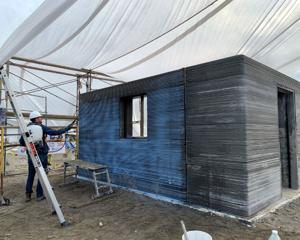Science
Researchers Innovate to Address Alaska’s Housing Crisis

The high cost and challenges of constructing affordable housing in Alaska have prompted researchers from the University of Alaska Fairbanks, the Cold Climate Housing Research Center (CCHRC), and the University of Virginia to seek innovative solutions. In a recent webinar co-hosted by CCHRC and the Arctic Research Consortium of the United States (ARCUS), experts outlined various strategies aimed at alleviating the housing crisis affecting communities from Fairbanks to Anchorage and beyond.
According to Rosa Vogel, program director at CCHRC, the state faces a dire need for new housing. “We really need more housing to be built in Alaska to solve a lot of the issues, and it has to be high-quality housing,” she stated. Current projections suggest that, at the present rate of construction, it would take approximately 180 years to meet Alaska’s housing demands.
CCHRC’s primary goal is to devise strategies that facilitate affordable construction, particularly in rural areas. Vogel emphasized the importance of prioritizing construction efforts, utilizing local materials, and fostering a skilled workforce. “We want to make sure we have a secure supply chain,” she added, highlighting that many communities rely on barge deliveries, which can be costly and prone to delays.
Innovative Partnerships and Adaptable Solutions
CCHRC has partnered with Alaska Adaptable Housing, a company focused on developing standardized building systems and design solutions. Together, they are working on an adaptable foundation system suitable for various environmental conditions, including permafrost.
Nima Farzadnia, director of UAF’s Institute for Northern Engineering Automated Construction and Advanced Materials Lab, noted potential solutions to the issues of supply chains and material costs. He called for innovative thinking and the integration of automation and artificial intelligence into construction practices. “We need to find out if these locally sourced materials are viable for mass construction,” he explained.
The last ARCUS conference held in Maine estimated that Alaska requires a minimum of 50,000 homes over an extended period to accommodate growing demand. A 2023 study by Agnew::Beck Consulting highlighted that at least 27,500 new housing units must be constructed within a decade to meet current needs.
Exploring Sustainable Materials
The Institute for Northern Engineering has established an automated construction lab to explore cost-effective methods, including three-dimensional printing and alternative construction materials. Farzadnia mentioned the potential of using indigenous materials with enhanced properties. For instance, mixtures combining volcanic ash and silt clay could be utilized. “Waste from one industry could be used for construction so we don’t have to import commodities from the Lower 48,” he noted.
In a demonstration of these innovative techniques, Farzadnia’s lab constructed a shed in 2024 using concrete made from coal fly ash collected from a Fairbanks power plant. “Not only can we produce concrete, we can also print these composite materials that can be used in construction,” he said. This summer, the lab took a significant step forward by printing a house in Nome, in collaboration with Penn State, CCHRC, Xtreme Habitats Institute, X-Hab 3D, and local authorities.
The project remains a work in progress, with ongoing assessments of supply chain management and the viability of locally sourced materials for mass construction. Farzadnia’s team has submitted a $30 million grant proposal to the National Science Foundation aimed at advancing AI software, tool development, and alternative-source materials for construction. He believes this could be a promising avenue for resolving Alaska’s building challenges.
Addressing Broader Climate Risks
The challenges of housing in Alaska extend beyond construction techniques and material sourcing. Jennifer Schmidt, an associate professor at the University of Alaska Anchorage, highlighted the intersection of housing and climate change. As co-leader of the Arctic Urban Risks and Adaptations project, she evaluates urban risks in Arctic and Subarctic communities, which include changing weather patterns, fire hazards, and permafrost instability.
Schmidt noted that lower-income households in Fairbanks are often situated in areas at high risk for wildfires. “You can see the effects of previous wildfires on the landscape,” she remarked. Resources like the Community Wildfire Protection Plans provide essential guidance for prospective homeowners and developers in assessing safe building locations.
The impact of climate change on infrastructure is an additional concern. Schmidt’s research indicates increasing winter rain events will exacerbate existing issues. “Fairbanks is just going to get worse,” she warned, pointing to the potential for ice slides and flooding due to frozen storm drains. Following severe weather events, the Fairbanks Public Works Department has faced challenges in managing stormwater.
Schmidt is currently involved in a project that assesses the stability of homes built on various types of permafrost and the consequences of its melting. She advises thorough research before purchasing or constructing homes in vulnerable areas.
As Alaska grapples with the pressing need for affordable housing, the collaboration among researchers, local communities, and organizations may pave the way for innovative solutions that leverage local resources and adapt to the region’s unique environmental challenges.
-

 Technology5 months ago
Technology5 months agoDiscover the Top 10 Calorie Counting Apps of 2025
-

 Health2 months ago
Health2 months agoBella Hadid Shares Health Update After Treatment for Lyme Disease
-

 Health3 months ago
Health3 months agoErin Bates Shares Recovery Update Following Sepsis Complications
-

 Technology4 months ago
Technology4 months agoDiscover How to Reverse Image Search Using ChatGPT Effortlessly
-

 Technology1 month ago
Technology1 month agoDiscover 2025’s Top GPUs for Exceptional 4K Gaming Performance
-

 Technology2 months ago
Technology2 months agoElectric Moto Influencer Surronster Arrested in Tijuana
-

 Technology5 months ago
Technology5 months agoMeta Initiates $60B AI Data Center Expansion, Starting in Ohio
-

 Technology5 months ago
Technology5 months agoRecovering a Suspended TikTok Account: A Step-by-Step Guide
-

 Health4 months ago
Health4 months agoTested: Rab Firewall Mountain Jacket Survives Harsh Conditions
-

 Lifestyle5 months ago
Lifestyle5 months agoBelton Family Reunites After Daughter Survives Hill Country Floods
-

 Technology4 months ago
Technology4 months agoHarmonic Launches AI Chatbot App to Transform Mathematical Reasoning
-

 Technology3 months ago
Technology3 months agoUncovering the Top Five Most Challenging Motorcycles to Ride





















